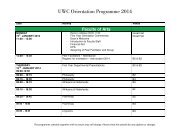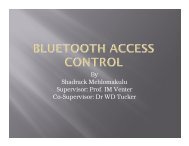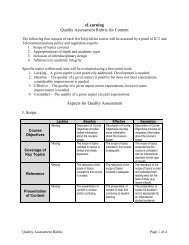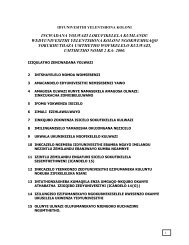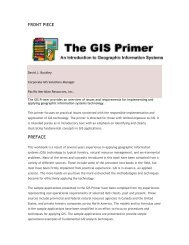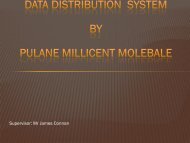Ecosystem Guidelines for Environmental Assessment
Ecosystem Guidelines for Environmental Assessment
Ecosystem Guidelines for Environmental Assessment
Create successful ePaper yourself
Turn your PDF publications into a flip-book with our unique Google optimized e-Paper software.
3. In terms of biodiversity process, identify or describe:<br />
a. The key ecological "drivers" of ecosystems on the site and in the vicinity, such as fire.<br />
b. Any spatial component of an ecological process that may occur at the site or in its vicinity<br />
(i.e. corridors such as watercourses, upland-lowland gradients, migration routes, coastal<br />
linkages or inland-trending dunes, and vegetation boundaries such as edaphic interfaces,<br />
upland-lowland interfaces or biome boundaries).<br />
c. Any possible changes in key processes, e.g. increased fire frequency or drainage/artificial<br />
recharge of aquatic systems.<br />
d. The condition and functioning of rivers and wetlands (if present) in terms of: possible<br />
changes to the channel, flow regime (surface and groundwater) and naturally-occurring<br />
riparian vegetation.<br />
e. Would the conservation of the site lead to greater viability of the adjacent ecosystem by<br />
securing any of the functional factors listed in (1)<br />
4. Would the site or neighbouring properties potentially contribute to meeting regional conservation<br />
targets <strong>for</strong> both biodiversity pattern and ecological processes<br />
For in<strong>for</strong>mation on conservation and biodiversity targets, contact the SANBI B-GIS Unit,<br />
or http://bgis.sanbi.org or the CapeNature Land Use Advisory Unit, Ph (021) 866-8000.<br />
5. Is this a potential candidate site <strong>for</strong> conservation stewardship<br />
Contact CapeNature at Ph (028) 314-0173 <strong>for</strong> in<strong>for</strong>mation on the stewardship programme.<br />
6. What is the significance of the potential impact of the proposed project, alternatives and related<br />
activities - with and without mitigation - on biodiversity pattern and process (including spatial components<br />
of ecological processes) at the site, landscape and regional scales<br />
7. Indicate on a topographical map or orthomap (preferably at a scale ≥ 1:10 000):<br />
- The area that would be impacted by the proposed development;<br />
- The location of vegetation, habitat and spatial components of ecological processes that should<br />
not be developed or otherwise trans<strong>for</strong>med; and<br />
- Areas, including the site and surrounds, that must remain intact as corridors or ecological<br />
"stepping stones" to maintain ecosystem functioning, including fires in fire-prone systems.<br />
8. Recommend actions that should be taken to prevent or, if prevention is not feasible, to mitigate impacts and<br />
restore disturbed vegetation or ecological processes. Indicate how preventative and remedial actions will be<br />
scheduled to ensure long-term protection, management and restoration of affected ecosystems and biodiversity.<br />
9. Indicate limitations and assumptions, particularly in relation to seasonality.<br />
10. Indicate how biodiversity considerations have been used to in<strong>for</strong>m socio-economic aspects of the<br />
proposed project, e.g. through changes to the location or layout of infrastructure, or retaining public<br />
access to biodiversity-related amenities or resources such as beaches or grazing.<br />
APPENDIX 2 : 93



